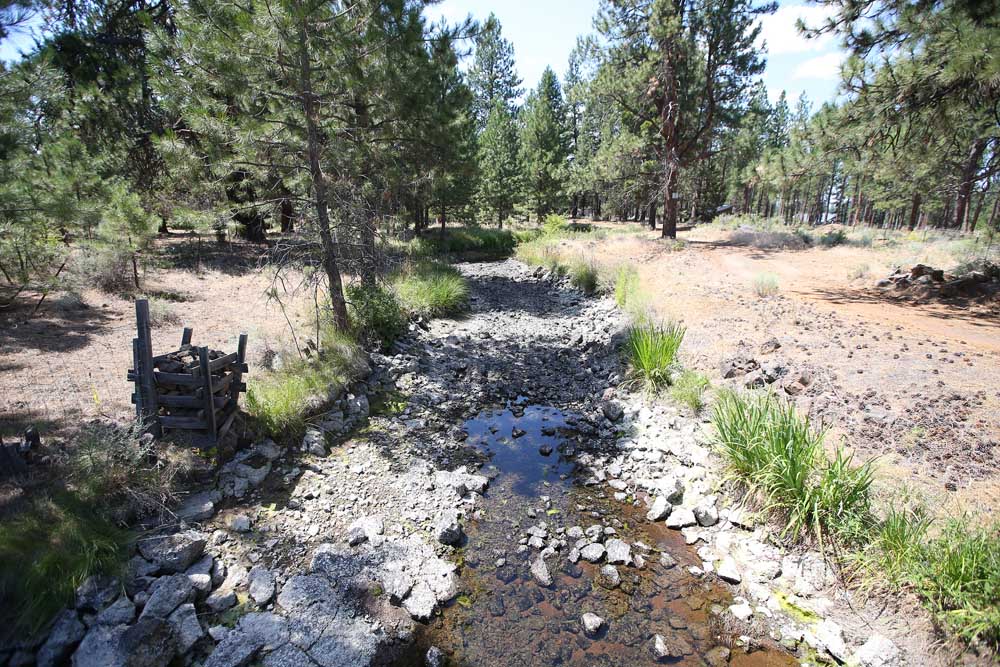Oregon spotted frog releases contribute to Arnold Irrigation District closure
Published 5:15 am Wednesday, August 2, 2023

- An Arnold Irrigation District canal near SW Brookswood Boulevard in Bend dries up Monday. Arnold customers found their ditches empty this week following another early shutdown of irrigation water. Arnold stopped its diversion Saturday amid reduced water levels in the Deschutes River caused by a historic drought and winter releases for the Oregon spotted frog.
Patrons of Arnold Irrigation District found their ditches empty this week following another early shutdown of the district’s irrigation season.
Arnold closed its diversion on Saturday amid reduced water levels in the Deschutes River caused by a historic drought and winter releases for the Oregon spotted frog.
A shutdown of water in July can cause serious problems for farmers who are usually in the middle of harvest season. Cattle ranchers living in the district are forced to purchase water and hay or move their animals to other irrigation districts with more senior water rights and greener pastures.
Arnold is a junior water rights holder in Central Oregon with 1905 rights that are behind the Swalley, Central Oregon and Lone Pine districts. It does have 5,000 acre-feet of storage rights in Crane Prairie Reservoir but mostly relies on live flow, which is water that naturally flows down the river from springs and runoff.
“Live flow right now is one of the lowest it has ever been,” said Steve Johnson, general manager for Arnold Irrigation District. “The spring was nice. There was moisture and low temperatures, but by the first week in June any contribution from snowmelt was gone.”
Johnson said the underground aquifer that charges springs flowing into the Deschutes is at reduced levels and spring-fed rivers that flow into the Deschutes are at the lowest levels since the 1980s.
“The aquifer is not getting replenished after multiple years of average or below-average snowpack,” he said. “So this is a continuing manifestation of the drought and low snowpack.”
Below average flows
As of Monday, the Deschutes River had a flow of 1,360 cubic feet per second below Benham Falls compared to 1,400 cfs on the same date a year ago, according to data compiled by the Bureau of Reclamation website. The historical average flow at Benham Falls is 1,996 cfs.
The Saturday closure was the second-earliest shutdown in district history. Last year, the diversion closed on July 23. Water shortages have forced the district to close early in each of the past four years.
Ethan O’Brien, an Arnold Irrigation District patron and cattle rancher, said he has gotten used to the annual early shutoff, but that doesn’t make the problem much easier to navigate.
“We have invested our own money to be able to farm and now anything we plant is going to die,” he said. “So it increases costs because we are constantly having to re-do everything.”
O’Brien, co-owner of North 44 farms, has picked up leases in other irrigation districts, allowing him to graze his cattle on nearby farms. But that has forced him to raise his prices to stay in business.
Another Arnold district farmer, Rob Rastovich, said the water shortages threaten to put small farms like his out of business, but the drought is just one part of a larger problem.
“It is Oregon’s antiquated water law, the political posturing of environment groups, and gross inefficiencies of senior water districts that are causing the Arnold Irrigation District turnoff,” he said.
Arnold patrons are not alone in the water shortages. Every district this year is facing curtailments and the threat of an early shutdown. Central Oregon Irrigation District, for example, is curtailed to 60% of normal, its lowest delivery amount since the district opened in 1905.
“We are hopeful we can maintain this for the remainder of the season,” said Craig Horrell, general manager for Central Oregon Irrigation District. “However, we are a district that relies on live flow, and if the springs that feed the Deschutes continue to dry up, we could go lower. At 60% our patrons are having to make choices on what fields to let go.”
Silver Lining
There is a silver lining to the early shutdown, Johnson said. Without water in the canal, the district can get a head start on its $35 million plan to pipe a section of the canal this winter.
The extra construction time this summer could allow the district to complete its canal-to-pipe project in April 2026, a year ahead of schedule.
“We are trying to make a little bit of lemonade, out of the lemon we have been dealt,” said Johnson. “We’re turning off early and thinking of how to maximize value for the district going forward.”
The project’s first phase includes installing 3.5 miles of pipe, conserving 11.2 cubic feet of water per second. Construction is scheduled for completion by April 2024, just in time for next year’s irrigation season.
Johnson explains that had the district completed the first phase of the project this year, patrons would be getting water for an additional two to three weeks.
When all four phases are complete, the project will conserve 32.5 cfs, equivalent to 11,100 acre-feet of water, or around 5% of the capacity of Wickiup Reservoir.
Because of agreements with other irrigation districts in the Deschutes Basin, some of the conserved water will go to North Unit Irrigation District, another junior water rights holder that has been devastated by drought in recent years.
North Unit will in turn release more water into the Deschutes River in winter from Wickiup Reservoir to enhance wildlife habitat.
“It will be noticeable, and as each phase gets done there will be more and more efficiency to the conservation of the district and providing water to North Unit, and in turn winter releases for the habitat and the Oregon spotted frog,” Johnson said.






